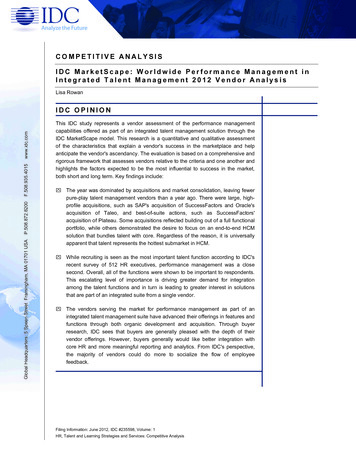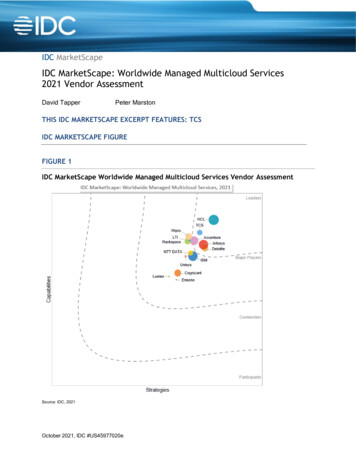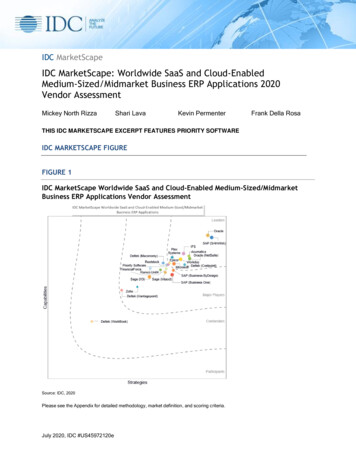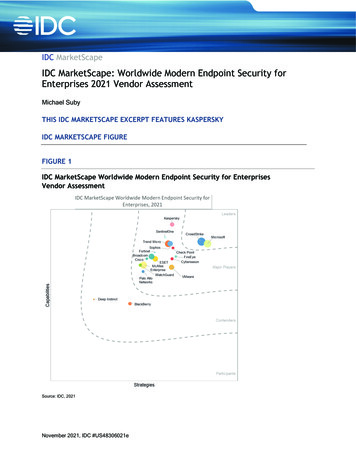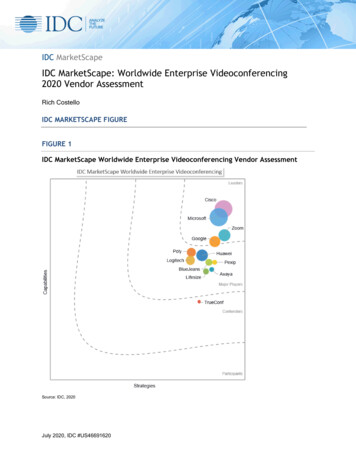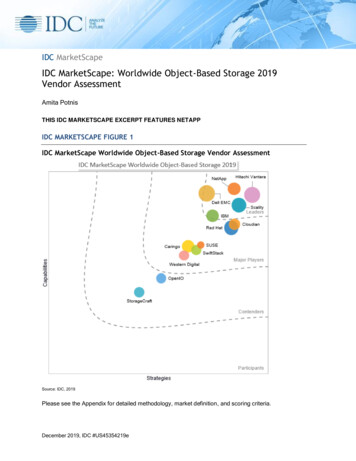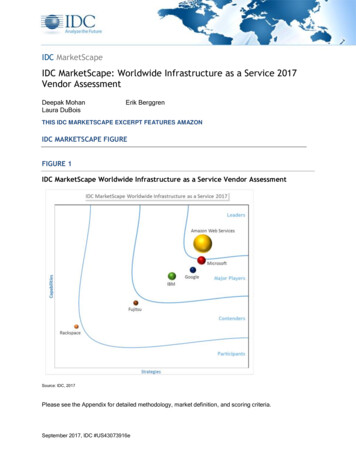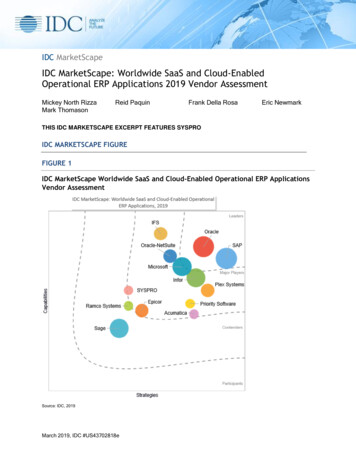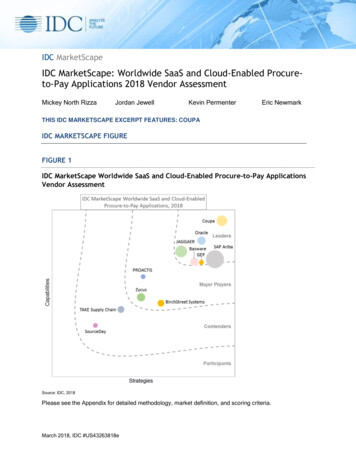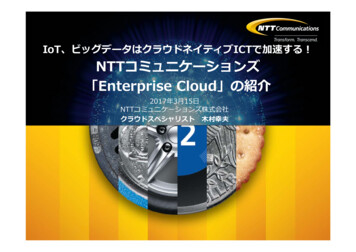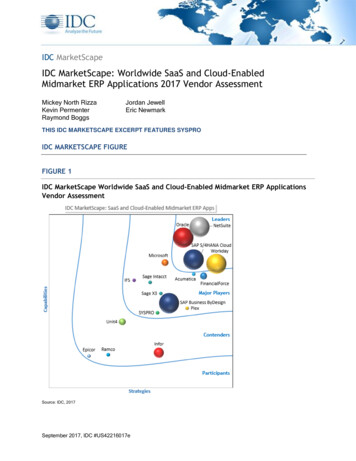
Transcription
IDC MarketScapeIDC MarketScape: Worldwide SaaS and Cloud-EnabledMidmarket ERP Applications 2017 Vendor AssessmentMickey North RizzaKevin PermenterRaymond BoggsJordan JewellEric NewmarkTHIS IDC MARKETSCAPE EXCERPT FEATURES SYSPROIDC MARKETSCAPE FIGUREFIGURE 1IDC MarketScape Worldwide SaaS and Cloud-Enabled Midmarket ERP ApplicationsVendor AssessmentSource: IDC, 2017September 2017, IDC #US42216017e
Please see the Appendix for detailed methodology, market definition, and scoring criteria.IN THIS EXCERPTThe content for this excerpt was taken directly from IDC MarketScape: Worldwide SaaS and CloudEnabled Midmarket ERP Applications 2017 Vendor Assessment (Doc # US42216017). All or parts ofthe following sections are included in this excerpt: IDC Opinion, IDC MarketScape Vendor InclusionCriteria, Essential Guidance, Vendor Summary Profile, Appendix and Learn More. Also included isFigure 1.IDC OPINIONDX Driving ChangeDigital transformation (DX) is fundamentally changing enterprise resource planning (ERP), allowingbusinesses to transform their decision making, which is enhancing their business outcomessignificantly as we enter the digital economy. Digital transformation is an enterprisewide, board-level,strategic reality for companies wishing to remain relevant or maintain or enhance their leadershippositon in the digital economy. Digitally transformed businesses have a repeatable set of practices anddisciplines used to leverage new business, 3rd Platform technology, innovation accelerators, andoperating models to disrupt businesses, customers, and markets in pursuit of business performanceand growth. DX is driving businesses to rethink their technology strategy, and that includes movingbeyond their legacy ERP and back-office systems. New sources of innovation and creativity toenhance experiences and financial outcomes is paving the way toward SaaS and cloud-enabled ERPsoftware.SaaS and Cloud-Enabled ERP SoftwareLeading DX businesses, of all sizes, have turned their focus to SaaS and cloud-enabled softwarebecause they need a flexible, agile ERP system that is configurable, continuously updated, quick toimplement, and scalable. Small and midmarket businesses find most SaaS and cloud-enabled ERPsystems are now within their ability to purchase and utilize, allowing their businesses to quickly expandand grow into new regions around the globe. It is now recognized SaaS and cloud-enable ERP meansERP systems are no longer just for the large enterprise as small and medium-sized businesses(SMBs) can now run their businesses similar to large enterprises — but with even more efficiencies andless frustration.SaaS and cloud-enabled ERP makes innovation easier than ever before, specifically when the righttechnology partner understands innovation strategies are critical success factors in the DX economy.As an example, the SaaS and cloud-enabled ERP software packages are becoming increasinglyintelligent with cognitive aspects such as machine learning, deep learning, natural languageprocessing, and advanced analytics on top of large curated data sets and in many cases using anassistive UI to navigate and uncover insights. The SaaS and cloud-enabled ERP solutions embeddedwith intelligence allow users to quickly establish more impactful data-driven business processes anddecisions, reduce the time to value, and significantly change the ability to generate more revenue,cash flow, and profitable growth. And, critical to profitability, operating costs are reduced becauseroutine tasks have been simplified, human errors eliminated, basic business processes automated;and additional drilldowns, data extraction, and analysis eliminated. 2017 IDC#US42216017e2
As more SaaS and cloud-enabled ERP vendors bring more intelligence to the business processes, weexpect small and medium-sized business to quickly move toward these vendors, immediatelyharnessing more technology and improving business value substantially.This IDC MarketScape helps end users evaluate 14 of the leading SaaS and cloud-enabled midmarketERP vendors servicing the industry. When evaluating vendors, key criteria to consider (all of which arediscussed in this study) include: Solution functionality, user interface (UI), ease of use, and ease of implementation andintegration with other systems Scalability, language support, pricing model, and the vendor's services focus, financialstability, and customer base Diligent vetting of customer references to examine solution pros/cons and the vendor'scustomer support, market knowledge, and overall level of value delivery Innovation and investment in the 3rd Platform and innovation accelerators, includingintelligenceIDC MARKETSCAPE VENDOR INCLUSION CRITERIAThrough its clients and contacts across most industries, IDC frequently has unique visibility into vendorselection processes within many companies. The vendor inclusion list for this document began withthose SaaS and cloud-enabled ERP solutions that IDC was familiar with having been evaluated forselection within recent midmarket ERP deals. IDC then supplemented those solutions with severaladditional ERP vendors that it believed also provided qualifying midmarket ERP systems. Vendorswere then surveyed and further investigated to ensure that their ERP systems qualified as SaaS orcloud enabled and were already serving midmarket clients, which IDC defines in Table 1. Ultimately,all ERP solutions included in this document met these criteria.After an initial evaluation of software vendors serving this market, which included each vendor's highlevel application capabilities and existing midmarket client base, IDC's Enterprise Applications teamextended formal invitations to software vendors to participate in our study. One vendor, QAD, declinedto participate in this study. The participating SaaS and cloud-enabled midmarket software vendors inthis study are: Acumatica Epicor FinancialForce IFS Infor Microsoft NetSuite Oracle Plex Systems Ramco Systems Sage SAP 2017 IDC#US42216017e3
SYSPRO Unit4 WorkdayAll vendors actively participated in the research with a total of 52 references contacted andinterviewed. Discussions with references included the systems utilized and their perception of thevendor and software in terms of technical support, account management, marketing message, level ofvalue delivered versus price paid, ease of integration, user interface, and ROI. In addition, referencesalso provided areas of improvement and their future business requirements.TABLE 1Cloud ERP Investment Plans of Midmarket and Small and Medium-SizedBusinesses (% of Respondents)Small BusinessesUse ERP (on-premises and cloud)Medium-Sized Businesses11.543.3Use ERP cloud8.925.2Plan to use cloud ERP in next 12 months7.310.5n 700Source: IDC's SMB IT Decision Maker Survey, 2016ADVICE FOR TECHNOLOGY BUYERSSaaS and cloud-enabled midmarket ERP suites are evolving with functionality improvements occurringas often as daily. From the addition of the 3rd Platform with big data and analytics, social, and mobileto the innovation accelerators of cognitive, 3D printing, robotics, IoT, and advanced security, thesystems continue to advance and improve at warp speed. Speed is the critical factor as we move intothe DX economy enabling businesses to significantly improve in terms of market share, revenue, andprofitability. It is recommended companies understand the current capabilities of their technologychoices, along with the strategic direction and investment their midmarket ERP software provider ismaking now and in the next three to five years. A guiding factor in our vendor research was the 3rdPlatform and innovation accelerators' current capabilities and the strategic and investment direction. Itis critical buyers look for a technology partner they can trust and that can take them well into the future.As SaaS and cloud-enabled ERP systems have increased in popularity, so too has the requirement forcompanies to utilize an ERP system regardless of their business size. Many large enterprise CFOsmove to small and medium-sized business and need an ERP package they are accustomed to but at afraction of the cost. CFOs of small and midsize organizations want to move beyond spreadsheets anddatabases to SaaS and cloud-enabled ERP software because it is an integrated, real-time businesssystem that is always accessible and grows with the business. In addition, the ability of the SaaS andcloud-enabled midmarket ERP software to perform as an enterprise-level ERP system, but with fewer 2017 IDC#US42216017e4
employees using the product, increasing productivity and efficiency factors, is a necessity. Last,organizations vary from product to services and require innovation to move beyond the current stateinto the intelligent enterprise world. SaaS and cloud-enabled ERP systems are the critical core to buildintelligent systems, which use machine learning, natural language processing on curated data sets,with advanced analytics and an assistive user interface across the resources of people, process andtechnology. These intelligent ERP (i-ERP) systems forecast, track, learn, route, analyze, predict,report, and manage business decisions and outcomes. Midmarket organizations, partnered with theright technology vendor, can successfully become an intelligent enterprise that is more effective,efficient, and highly profitable.A small set of vendors have already invested in the 3rd Platform and innovation accelerators, utilizingthese innovation areas to deliver higher value to their customers, while others are just beginning thisinvestment journey. Several vendors outlined in this research study have more manufacturing depthand breadth than services in their software. Some of the vendor offerings are both product andservices centric. And some are still moving from on-premises to single tenancy and just beginning theirjourney toward multitenancy.Before making purchasing decisions on SaaS and cloud-enabled midmarket ERP software,businesses should consider: With levels of experience successfully implementing midmarket ERP solutions, does thevendor have experience with my type of product, service, and company size? Is the vendor knowledgeable about midmarket ERP requirements as they affect my company? Does the vendor understand the regulations that will impact my business? How are theseregulations reflected in my current product, and how will it change in the future? What levels of support are available, and are they geographically available for my business? What are my internal support resources and capabilities? Should I hire a third party to plan and assist with the implementation of the solution? Is the vendor financially able to provide needed support? Can it support needed investment inthe development of future midmarket ERP software requirements? Is the vendor committed to this market in the long term? Is the ROI achievable? Does the vendor have a track record of meeting the ROI requirements? Can the vendor or partners support my foreign operations? Can the vendor integrate with my company's other IT systems and those of my partners? Is the product available anywhere and anytime? Is the product updated frequently enough for my business needs? What new innovations is the vendor considering? How and when will it impact my business? What is the vendor's strategic investment outlook for the next three to five years? Why? Will the vendor be a partner, helping my business grow now and in the long term?This IDC MarketScape vendor assessment assists in answering these questions and others. Some ofthe references that participated in this study noted the current state of the SaaS and cloud-enabledmidmarket ERP software market continues to evolve and is starting to pick up momentum — muchmore than in previous years. In addition, many of the references were impressed there are now morevendor choices within the midmarket ERP market. IDC expects some consolidation and specialization 2017 IDC#US42216017e5
by niche may occur as the market matures and as midmarket ERP software vendors look to addadditional capabilities to their portfolio of products.VENDOR SUMMARY PROFILEThis section briefly explains IDC's key observations resulting in a vendor's position in the IDCMarketScape. While every vendor is evaluated against each of the criteria outlined in the Appendix,the description here provides a summary of one vendor's strengths and challenges.SYSPROAfter a thorough evaluation of SYSPRO's offerings and capabilities, IDC has positioned the companyin the Major Players category of this IDC MarketScape.SYSPRO is a global provider of ERP software designed to be deployed on-premises, deployed in thecloud, or accessed via a mobile device. Headquartered in Johannesburg, South Africa, SYSPRO has500 employees and over 15,000 licensed companies installed in 62 countries. SYSPRO solutions aretargeted to manufacturing and distribution companies and include functionality for corporateperformance management, distribution management, manufacturing operations management,governance/compliance management, inventory optimization, sales and operations planning, supplychain optimization, traceability, and industry-specific requirements.StrengthsSYSPRO boasts strong customer satisfaction, with a customer retention rate of 98%. This reflectsSYSPRO's focus on building/maintaining trust-based customer relationships by implementing aprocess-modelled deployment framework, launching a digitally accessible education/trainingmethodology, and providing a full range of customer service options, among other things. SYSPRO'scustomer retention rate is the result of significant effort to understand their customer base.SYSPRO is also delivering artificial intelligence (chatbots), new machine learning, and social ERPcapabilities. It has partnered with Microsoft Azure for cloud deployment delivering a high level ofaccessibility and flexibility, as SYSPRO increases its penetration into large global accounts.SYSPRO has developed extensive industry-level expertise in the manufacturing and distributionmarket sectors. SYSPRO tailors its broader ERP solution for several subverticals, including chemicals,food and beverage, plastics, metal fabrication, machinery and equipment, medical devices (UnitedStates), electronics, and automotive industries.ChallengesSYSPRO has a brand awareness disadvantage compared with other midmarket ERP providers,especially in the North American market. The North American vendor landscape for midmarket ERPsolutions is very crowded, and it can be very difficult to be heard even with large marketing spend.SYSPRO has poured its corporate resources into R&D and service/support capabilities versusmarketing. This leaves SYSPRO vulnerable to midmarket ERP vendors with larger marketing budgetsor more sophisticated marketing strategies.SYSPRO is not a household name like some other midmarket ERP providers. The company isrecognized by industry insiders operating within SYSPRO's targeted microverticals. SYSPRO's growth 2017 IDC#US42216017e6
challenge remains to better leverage the company's reputation through more aggressive brandawareness marketing to become a major household name.Consider SYSPRO WhenConsider SYSPRO if you are a company specializing in engineer to order, make to order, make tostock, mixed mode, assemble to order, batch, discreet or process manufacturing, and distribution andare looking for a company with deep expertise in your market and a software solution that is tailored toyour niche manufacturing market.APPENDIXReading an IDC MarketScape GraphFor the purposes of this analysis, IDC divided potential key measures for success into two primarycategories: capabilities and strategies.Positioning on the y-axis reflects the vendor's current capabilities and menu of services and how wellaligned the vendor is to customer needs. The capabilities category focuses on the capabilities of thecompany and product today, here and now. Under this category, IDC analysts will look at how well avendor is building/delivering capabilities that enable it to execute its chosen strategy in the market.Positioning on the x-axis, or strategies axis, indicates how well the vendor's future strategy aligns withwhat customers will require in three to five years. The strategies category focuses on high-leveldecisions and underlying assumptions about offerings, customer segments, and business and go-tomarket plans for the next three to five years.The size of the individual vendor markers in the IDC MarketScape represents the market share of eachindividual vendor within the specific market segment being assessed.IDC MarketScape MethodologyIDC MarketScape criteria selection, weightings, and vendor scores represent well-researched IDCjudgment about the market and specific vendors. IDC analysts tailor the range of standardcharacteristics by which vendors are measured through structured discussions, surveys, andinterviews with market leaders, participants, and end users. Market weightings are based on userinterviews, buyer surveys, and the input of IDC experts in each market. IDC analysts base individualvendor scores, and ultimately vendor positions on the IDC MarketScape, on detailed surveys andinterviews with the vendors, publicly available information, and end-user experiences in an effort toprovide an accurate and consistent assessment of each vendor's characteristics, behavior, andcapability.Market DefinitionThis MarketScape evaluation focuses on SaaS and cloud-enabled midmarket ERP solutions. Refer toTable 2 for IDC's definition of "midmarket."ERP is a packaged integrated suite of technology business applications with common data andprocess models that digitally support the administrative, financial, and operational business processesacross different industries. These processes manage resources including some or all of the following: 2017 IDC#US42216017e7
people, finances, capital, materials, suppliers, manufacturing, supply chains, customers, products,projects, contracts, orders, and facilities.ERP suites and the associated applications are utilized to run the business and typically start withfinance and include procurement and inventory/asset management and may also include HCM, ordermanagement, manufacturing, distribution, services, engineering, PLM, and supply chain. The softwarecan be specific to an industry or designed to be more broadly applied to a group of industries.Typically, ERP suites are architected with an integrated set of business rules and metadata, accessinga common data set (logical or physical) from a single, consistent user interface. ERP suites areavailable as on-premises, hybrid and, increasingly, cloud SaaS deployments.LEARN MORERelated Research Worldwide Software as a Service and Cloud Software Forecast, 2017–2021 (IDC#US42014217, July 2017) Organizing the Organization for Digital Transformation Success, Part 2: Successful DigitalTransformation — Key Considerations (IDC #US42580317, July 2017) IDC PlanScape: Intelligent ERP for Digital Transformation (IDC #US42800017, June 2017) Organizing the Organization for Digital Transformation Success, Part 1: Defining DigitalTransformation, Types of Transformation, and Core Competencies (IDC #US42580217, June2017) i-ERP (Intelligent ERP): The New Backbone for Digital Transformation (IDC #US41732516,September 2016)SynopsisThis IDC study provides an assessment of the leading SaaS and cloud-enabled ERP softwaresolutions for midmarket enterprises and discusses what criteria are most important for companies toconsider when selecting a system.Mickey North Rizza, program vice president of IDC's Enterprise Applications and Digital Commerce,stated, "The SaaS and cloud-enabled midmarket ERP market has a mix of competitors from small andmedium-sized to large technology vendors. Selecting the right vendor partner is critical to your longterm strategy as a business. Most importantly, SaaS and cloud-enabled ERP is a disrupter asbusinesses of all sizes want to purchase it because it is easily configured, updated as needed for allcustomers, and readily available anywhere for most business types." 2017 IDC#US42216017e8
About IDCInternational Data Corporation (IDC) is the premier global provider of market intelligence, advisoryservices, and events for the information technology, telecommunications and consumer technologymarkets. IDC helps IT professionals, business executives, and the investment community make factbased decisions on technology purchases and business strategy. More than 1,100 IDC analystsprovide global, regional, and local expertise on technology and industry opportunities and trends inover 110 countries worldwide. For 50 years, IDC has provided strategic insights to help our clientsachieve their key business objectives. IDC is a subsidiary of IDG, the world's leading technologymedia, research, and events company.Global Headquarters5 Speen StreetFramingham, MA 01701USA508.872.8200Twitter: @IDCidc-community.comwww.idc.comCopyright and Trademark NoticeThis IDC research document was published as part of an IDC continuous intelligence service, providing writtenresearch, analyst interactions, telebriefings, and conferences. Visit www.idc.com to learn more about IDCsubscription and consulting services. To view a list of IDC offices worldwide, visit www.idc.com/offices. Pleasecontact the IDC Hotline at 800.343.4952, ext. 7988 (or 1.508.988.7988) or sales@idc.com for information onapplying the price of this document toward the purchase of an IDC service or for information on additional copiesor web rights. IDC and IDC MarketScape are trademarks of International Data Group, Inc.Copyright 2017 IDC. Reproduction is forbidden unless authorized. All rights reserved.
additional ERP vendors that it believed also provided qualifying midmarket ERP systems. Vendors were then surveyed and further investigated to ensure that their ERP systems qualified as SaaS or cloud enabled and were already serving midmarket clients, which IDC defines in Table 1. Ultimately, all ERP solutions included in this document met .
